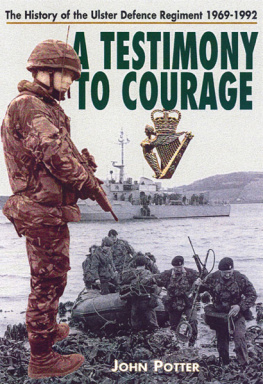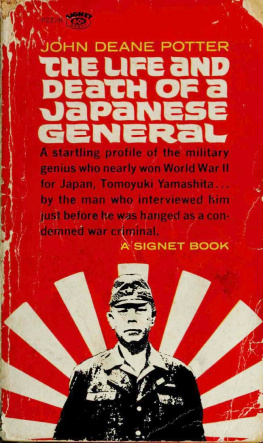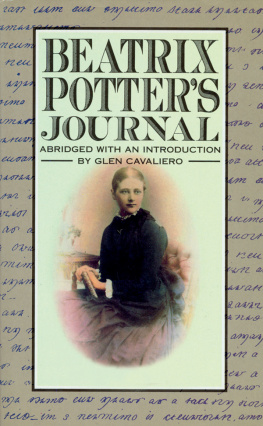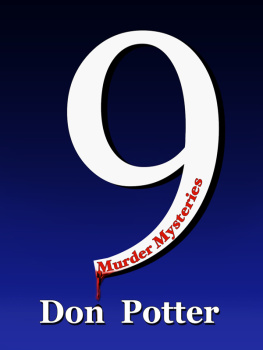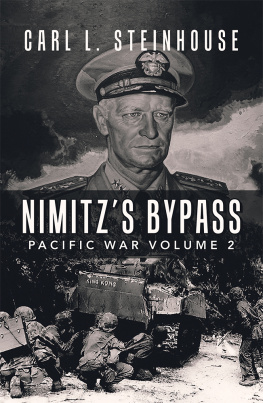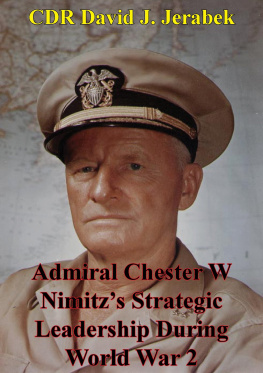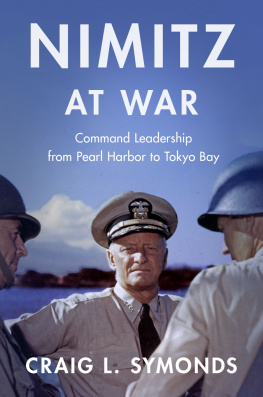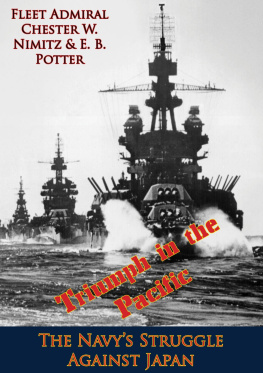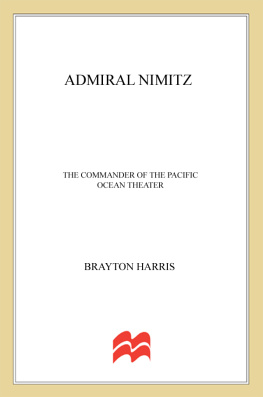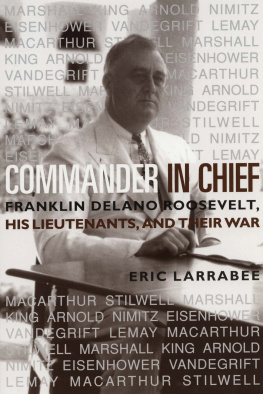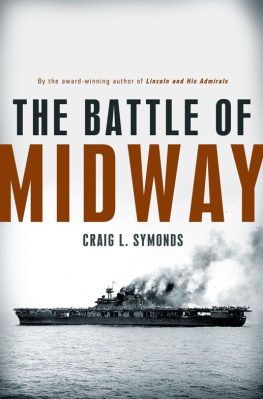NIMITZ
E. B. POTTER

NIMITZ
NAVAL INSTITUTE PRESS
ANNAPOLIS, MARYLAND
Naval Institute Press
291 Wood Road
Annapolis, MD 21402
1976 by E. B. Potter
All rights reserved. No part of this book may be reproduced or utilized in any form or by any means, electronic or mechanical, including photocopying and recording, or by any information storage and retrieval system, without permission in writing from the publisher.
First Naval Institute Press paperback edition published in 2008.
ISBN: 978-1-61251-225-9 (eBook)
Library of Congress Cataloging-in-Publication Data
Potter, E. B. (Elmer Belmont), 1908
Nimitz / E.B. Potter.
p. cm.
Includes bibliographical references and index.
1. Nimitz, Chester W. (Chester William), 18851966. 2. AdmiralsUnited StatesBiography. 3. United States. NavyBiography. I. Title.
V63.N55P67 2008
940.545973092dc22
[B]
2007037189

 Print editions meet the requirements of ANSI/NISO z39.48-1992 (Permanence of Paper).
Print editions meet the requirements of ANSI/NISO z39.48-1992 (Permanence of Paper).
The author is grateful for permission to quote from the following publications: George Allen & Unwin, Ltd., for Nice to Have You Aboard by Captain Harold Hopkins, RN; Harold Ober Associates Incorporated for Admiral Halseys Story (published by McGraw Hill Book Company, Inc.) by William F. Halsey and J. Bryan III, copyright 1947 by William F. Halsey, copyright 1947 by The Curtis Publishing Company; Random House, Inc., for The Rising Sun: The Decline and Fall of the Japanese Empire, 19361945, by John Toland, copyright 1970 by John Toland; Hawthorne Books for General Kenney Reports: A Personal History of the Pacific War by George C. Kenney, copyright 1949 by George C. Kenney; Little, Brown and Company for The Quiet Warrior by Thomas B. Buell, copyright 1974 by Thomas B. Buell; U.S. Naval Institute Proceedings, July 1966; W. W. Norton and Company, Inc., for Fleet Admiral King: A Naval Record by Ernest J. King and Walter Muir Whitehill, copyright 1952 by Ernest J. King; Once a Marine: The Memoirs of General A. A. Vandegrift, United States Marine Corps, by A. A. Vandegrift and Robert B. Asprey, copyright 1964 by A. A. Vandegrift and R. B. Asprey; Present at the Creation: My Years in the State Department by Dean Acheson, copyright 1969 by Dean Acheson.
The author also thanks Samuel Eliot Morison for permission to use material from The Rising Sun in the Pacific (published by Little, Brown and Company, copyright 1948 by Samuel Eliot Morison) in preparation of the map on page 38 in this book.
Unless otherwise indicated, all photographs are official U.S. Navy.
18 17 16 15 14 13 9 8 7 6 5 4
To Grace, Katherine, and Lorraine
CONTENTS
MAPS
FLEET ADMIRAL NIMITZS almost obsessive discretion may have had its roots in the notorious Sampson-Schley controversy, which was going on while Nimitz was a student at the Naval Academy. The controversy embarrassed friends of the Navy and permanently injured the reputations of both Rear Admiral William T. Sampson and Commodore Winfield S. Schley. Young Nimitz, shocked by the undignified bickering, vowed to himself that there would be no more such washing of the Navys dirty linen in public if ever he was in a position to prevent it. During the rest of his life, he avoided and, insofar as possible, forestalled public controversyparticularly where it involved personalities. He made every effort to protect the feelings and reputations of his subordinates, even when they failed to measure up.
Admiral Nimitz deplored the rushing into print of many World War II officers, particularly when their revelations tended to dim the prestige of other officers or to stimulate public wrangling. For his own part, he would not write his biography or permit it to be written during his lifetime, and even in his personal letters he carefully withheld censure and all facts on which censure might conceivably be based. There was one exception. In his daily wartime letters to his wife he freely let off steam, expressing his exasperation at the conduct or shortcomings of some of his associates. She understood that these comments were for her eyes alone. It was just sort of a safety valve for him to do this, she said. To ensure that the contents of the letters should never be made public, she burned all except a few of the blandest.
To his friend Andrew Hamilton, Admiral Nimitz said, People ask me why I havent written my memoirs. My answer has always been that history is best written by the professional historians. A wartime military commander is likely to be too emotionally involved to present an objective picture of himself or his associatesand his prejudices might hurt the people he served with.
For the use of his future biographer, Nimitz carefully collected his papers and saw that they were deposited in the Operational Archives of the Naval History Division in Washington, D.C., under the care of Rear Admiral Ernest M. Eller, then Director of Naval History. In January 1965, he submitted to two long interviews by John T. Mason, Jr., representing the Columbia University oral history project, but he would not permit his replies to be recorded on tape. Mason made copious notes and then rushed to his hotel and reproduced the interviews as completely as possible on his tape recorder.
Not long after Admiral Nimitzs death in 1966, Admiral Eller interested the eminent historian Allan Nevins in writing the Nimitz biography. Nevins had begun his research and engaged C. M. Nelson as his research assistant when he was stricken with an illness from which he did not recover.
In 1969, the U.S. Naval Institute established its own oral history program with John Mason at its head. Mason took as his first project the collecting of more materials for Nimitzs biographer, whoever he might be. He began by interviewing Chester Nimitz, Jr., and his wife Joan at their home in Connecticut. Chester, Jr., expressed the opinion that the time was ripe for a biography of his father but told Mason that his mother, Mrs. Chester Nimitz, Sr., was the one to give the green light for such a work.
Mrs. Nimitz, Sr., then living in San Francisco, readily granted Mason a series of interviews. She told him that she wanted the biography written and that she would like Professor Potter to write it. He knew the admiral, she said. Professor Potter worked with him and he has been a guest in our home. I think thats important.
The rest of the family agreed with Mrs. Nimitz. All granted extensive interviews, which were recorded on tape, transcribed, and submitted to the interviewees for correction. Mason and his assistant, Etta-Belle Kitchen, then traveled to various parts of the United States and even abroad to interview former associates of Admiral Nimitz. Unfortunately, by 1969 some of the senior officers who had been most closely associated with Nimitz in World War II were dead, and others were too ill to be interviewed.
I learned of these proceedings shortly after Masons visit with Mrs. Nimitz. Commander R. T. E. Bowler, Jr., Secretary-Treasurer and Publisher, U.S. Naval Institute, invited me to his office and offered me a contract to write a biography of Admiral Nimitz. I promptly accepted the offer, and signed the contract early in 1970.
I caught my first glimpse of Admiral Nimitz in 1943 when I was on duty as a naval reserve officer at Pearl Harbor. He was riding by in the back seat of a big, black car. Later the same year, I heard him address the personnel of the 14th Naval District. I was at that time working in the vaultlike basement of the district administration building. This was the basement described at the beginning of of this book, though by 1943 it was being used for distributing codes rather than breaking them.
Next page


